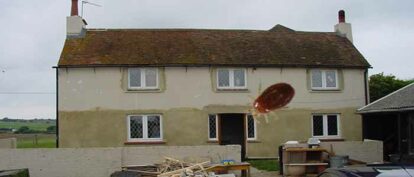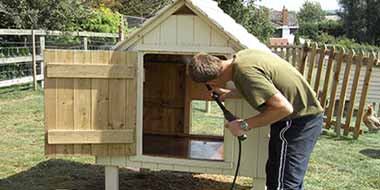
Guide to
Red Mite

This in-depth guide will tell you everything you need to know about red mite, how to identify them and more importantly, how to control them.
Red mites (Dermanyssus gallinae) are blood-feeding ectoparasites that live in small cracks inside poultry houses, coming out at night for a blood feed from chickens and turkeys during the warmer months. They are difficult to eradicate and have significant welfare and egg production implications in commercial and backyard flocks.
Red mites are not species-specific and will feed on any type of bird, although ducks and geese are not normally affected because they do not roost and are relatively active, moving around their house at night.
An infestation of red mites (also called chicken mites, roost mites or poultry mites) will cause skin irritation, stress and a reduction in egg numbers. In extreme cases, birds will become anaemic and can even die.
They are particularly resilient. In the wild, red mites will live inside bark cracks of trees, waiting for long periods of time between feeds until a bird roosts nearby. I ran an experiment (more on this later), keeping red mites in jam jars, and they lived for nearly 8 months without a feed…
Although mites usually spend the day hidden in cracks, only going onto birds at night for an hour or so to feed, a few can remain on a bird (maybe by accident) and get transported to new locations (for example, when birds are sold).

(Copyright!)
Although there is little research to support this, it is believed that wild birds can also bring red mite into a flock. Still, some intermediate hosts can carry them, such as dogs or humans (usually on clothing) when visiting poultry houses or handling birds.
Red mite life cycle
How quickly they multiply!
I based the diagram below on the work of Sparagano, et. al.1 It shows the life cycle of the female red mite, Dermanyssus gallinae. It is essential to understand their life cycle in order to have a better understanding of how to treat red mites on chickens. By breaking their life cycle, (e.g. re-treating a red mite infestation before any remaining adults lay more eggs) increases your chances of getting rid of red mites!

Diagram explanation
The timing shown assumes normal British summer temperature and humidity. The complete life cycle is shortest during hot, humid weather. A typical cycle during the summer is only 7-10 days long.
A blood feed takes 1 to 2 hours and usually takes place at night when birds are roosting.
- Eggs hatch into 6 legged Larvae in 2-3 days. They do not feed.
- Larvae moult into 8 legged Protonymphs in 1-2 days and start to feed.
- Protonymphs will have a blood feed and turn into Deutonymphs in another 1-2 days
- Deutonymphs turn into adult red mites in 2-3 days and continue to take blood feeds
- After feeding a female red mite will mate and within 1-2 days is laying eggs.
- Females will routinely take a blood feed. Males feed less frequently.
- The cycle is of course repeated and numbers increase…
Important to note:
- Temperature: the speed of the red mite life cycle depends on temperature and humidity. Red mite are inactive and cannot reproduce below 9°C so are usually only a problem for us between May and October in Europe.
- Life cycle: their life cycle takes a couple of weeks when the temperature is in the 10-20°C range, but increase the temperature to 25-30°C with 70% humidity and the lifecycle decreases to less than a week! This is why it’s important to re-treat houses every 3-4 days before Protonymphs and Deutonymphs that escaped the first treatment can turn into egg laying adults.
- Reproduction: In order to lay eggs, the female red mite must have a blood feed. She lays a clutch of around 8 eggs so under favourable weather, red mites can multiply dramatically in just a few weeks. Getting rid of red mites becomes much more difficult during warm weather!
What are red mites?
How to identify them.
Red mites are small, up to 1mm long and 0.7mm wide, slow-moving mites. They range in colour from a very light grey, almost translucent to a light brown, black and blood-red colour after a feed. Their eggs are harder to spot with the naked eye at around 0.4mm and translucent, white in colour.

The macro photograph above (x5 magnification) shows some red mite at different stages of their life cycle from tiny white / translucent eggs to (what I think) is a grey protonymph that hasn’t fed yet and finally, a fully grown red adult mite, after a feed. This photo is of a crack of wood inside a poultry house before I fried them to a crisp with a blow torch!
The next photo is from the inside one of my larger chicken coops. You may wonder why the mites aren’t in cracks. It’s because the coop door normally closes against this piece of wood, leaving a small gap.
Again, if you look carefully, you can see mites at different stages of the life cycle: from eggs to adults. I would guess that the really dark red adult mites had a feed the night before on my chickens.

Note the bits that look like cigarette ash (especially around the edges). This is their excreta and can often be seen outside of cracks where mites are hiding.
More photos of mite infestations are in the “Mitey Gallery” at the end of this guide.
How to check your coop for red mite
Here's how to check if your chicken house has red mites:
- Look for colonies of red mites and their excreta (that looks like cigarette ash) close to where birds roost at night. Check perch ends for evidence. If perches are removable, this makes it easier to find them. Sometimes when collecting chicken eggs, they will have mites crawling on them red ‘blood spots’ (actually squashed mites).
- After dark, red mites will be active, crawling out and along perches to get to their hosts for a blood feed. Using a torch, look for mites crawling along perches and walls of housing. Wipe the underside of the perch with a white tissue and look for smears of blood. Birds will be restless as they get bitten by mites. They may not want to go in their house to roost / may roost in the run.
- Egg production will usually decrease and eventually birds will stop laying. They may lay outside or on the floor of the coop because they get bitten whilst sitting in nest boxes. Egg yolks can be pale.
- Birds will start to lose condition. As the infestation gets worse, they are losing a lot of blood. They will have a pale comb and wattles. They will become anaemic and eventually they will die. Birds at the bottom of the pecking order are often forced to roost near the worst infestation so are often the first to die.
Video Clip: Red mite in a chicken house
This short video clip shows some red mite I found in a plastic chicken house. Plastic coops don’t stop red mite but they can be easier to clean out.
Red Mite Control
How to treat your chicken coop
 Eradicating red mite completely is very difficult. Even when deep cleaning poultry housing and treating birds, it only takes a few red mites or eggs to escape and they will quickly multiply again. It is usually best to deep clean housing when you discover the problem, then have an ongoing regular checks and a treatment plan to stay on top of their numbers.
Eradicating red mite completely is very difficult. Even when deep cleaning poultry housing and treating birds, it only takes a few red mites or eggs to escape and they will quickly multiply again. It is usually best to deep clean housing when you discover the problem, then have an ongoing regular checks and a treatment plan to stay on top of their numbers.
Red mites can survive without a blood feed for six to eight months so leaving the coop empty for a short while won’t kill them although changing housing and treating one house while the birds is in the other can certainly help.
Felt roofs
Unfortunately if your chicken coop has a felt roof, it is usually impossible to kill the colonies of red mite that form underneath the felt, without removing and re-felting the roof. It is for this reason that I would recommend you remove felt roofs and replace them with some other material. Onduline in popular and available at most DIY stores. It is easy to cut with a saw to size and leaves no space for red mite to hide.
Control methods
Here are some ways that people control red mites. Some I have used myself, some I haven’t, so I can’t say how successful they all are. I have adopted a more organic approach to flock management recently, and a few of these methods rely on some fairly strong chemicals, so be careful not to harm yourself or your birds if you decide to try some of these!
- Creosote applied at least annually to the hen-house. It would help if you had the ‘old fashioned’ creosote (banned in 2003). Sadly Creosote substitute sold in DIY stores doesn’t seem to have the same result. It is illegal to sell or use Creosote now unless it is for professional use. It can still usually be bought from agricultural suppliers.
- Paint Paraffin into cracks and crevices.
- Blowtorches are useful around the cracks and crevices, but please be careful not to set fire to your coop! Please don’t use a blow torch on a plastic coop… yes, it will melt!
- Steamers like this one used for stripping wallpaper and used to get into crack work really well.
- Pressure Washers like this one are used to spray into cracks to wash out mites.
- Smearing a mixture of Paraffin and Vaseline into cracks and crevices. Poultry keepers use Vaseline to get rid of scaly leg mites. It smothers the mites.
- Double-sided sticky flypapers / double-sided sticky tape on the underside of the perch and/or around ends of perches.
- Corrugated cardboard – make ‘traps’ to fit on the underside of perches. As these fill up, remove them and burn.
- Coke (no particular brand) poured into cracks to wet the mites apparently works by dissolving the waxy outer coating of the mite, which then causes them to dehydrate and die. Worth a try!
- A dust bath can really help the birds with mites and lice and is their natural way of getting rid of external parasites. Dusting powders are added to dust baths (like Diatomaceous Earth), so the birds get it into the places you have missed. When mites hop onto your birds at night, they will rub against the diatom.
Tip: Stay on top of red mite infestations
Perform a weekly check for red mites during warm weather. You will usually find them between the months of May and October in Europe.
Products to kill red mite
Red mite killers!

Commercial products
There are products used in commercial poultry housing for getting rid of red mite, however most of these are only available in very large quantities so aren’t suitable or cost effective for backyard flocks with smaller houses.
Exzolt
There is a new (end of 2017) noteworthy commercial product from MSD Animal Health called Exzolt. This is different to other commercial products because it is added to the drinking water. The active ingredient is called fluralaner and this is absorbed by the gut and enters the bird’s bloodstream. It attacks the female mite’s nervous system and causes the mite to die after a blood feed.
Exzolt is administered twice, 7 days apart so that it treats two mite life cycles and trials have shown a 99% kill rate. There is no egg withdrawal period and there is a short 14 day withdrawal for meat.
It is currently only available in commercial sizes and the dosing needs to be accurate according to the weight of the bird so mixed flocks of bantams and large fowl would need separating. Add to this that it is only available on prescription from a vet, it is still out of reach for most of us with back garden poultry but might be of interest if you are a breeder with large numbers.
Insecticides
Most insecticides contain permethrin which is a synthetic pyrethroid derived from dried flowers of the Chrysanthemum Daisy. Permethrin works as a contact insecticide that damages the nervous system of the insect. It is an effective insecticide and has a low toxicity in mammals.
Most products containing permethrin come in powder form for dusting the bedding and perches. They remain active for some time but do need re-applying after cleaning the house out.
Insecticides should not be used on the birds themselves unless they are tested for use on birds laying eggs for human consumption. The cost to go through this sort of extensive testing is high and there is a very limited market for a company to invest in this for the backyard poultry market (commercially it wouldn’t viable to treat each bird individually).
‘Spot-On’ products
 Using sprays or “spot-on” treatments often classified under the Small Animal Exemption Scheme is prohibited. These are products designed for cage birds, pigeons or other small animals (for example containing ivermectin).
Using sprays or “spot-on” treatments often classified under the Small Animal Exemption Scheme is prohibited. These are products designed for cage birds, pigeons or other small animals (for example containing ivermectin).
They are not tested for residues in eggs that are laid for human consumption.
If you really want to use these, then only a Veterinary Surgeon is able to prescribes them, under their Cascade scheme. They will also be able to advise you on the egg withdrawal period (usually a minimum of 7 days) for safety.
Considering red mite infest poultry housing, there are usually better ways to control them. Read on!
Disinfectants
There are some chemical based disinfectants that are red mite killers. The most well known and easy to buy is Jeyes Fluid which will kill red mite. It is diluted down from the tin with water so will last a long time. When dealing with chemical disinfectants, remember they are also harmful if you get them on your skin or worse still, in your eyes so please follow the manufacturer’s instructions carefully.
Organic treatments
These are broken down into three broad categories:
- Powders: Diatomaceous earth or silica based products that are microscopically sharp. They pierce the outer, waxy coating of the mite causing them to dehydrate and die.
- Liquid detergents: These break down the waxy coating off the mite which will again cause them to dehydrate and die.
- Natural oils: Provide an inhospitable environment for mites to live in.
Some products contain more than one of these, for example diatomaceous earth and tea tree oil in a powder.
With organic treatments, they take time to be effective and repeat treatments are often necessary. It is best to combine at least a couple of types of product, for example, liquid detergents are useful since they will run into the cracks and crevices. They can also be sprayed into difficult to reach areas. Once the coop is dry, you can use a dusting powder (concentrated on the perch ends and nest boxes) to catch mites that you missed and as they come out at night to feed and try to get to birds.
Poultry Shield
 Poultry Shield is the most popular red mite product by far. It is a multi-purpose cleaner / detergent / sanitizer that is good to use for regular cleaning of the coop but is also very effective at killing red mite. The manufacturer states that it is not caustic and contains no insecticide, it simply washes the waxy coating off the mite, causing it to dehydrate and die. This makes it safe to use (following the manufacturer’s instructions of course) and can even be used with your birds inside the house although I’ve never used it like this.
Poultry Shield is the most popular red mite product by far. It is a multi-purpose cleaner / detergent / sanitizer that is good to use for regular cleaning of the coop but is also very effective at killing red mite. The manufacturer states that it is not caustic and contains no insecticide, it simply washes the waxy coating off the mite, causing it to dehydrate and die. This makes it safe to use (following the manufacturer’s instructions of course) and can even be used with your birds inside the house although I’ve never used it like this.
You can buy Poultry Shield here.
I always keep Poultry Shield in stock because outside of the red mite season, it is useful for cleaning out the chicken coop. After cleaning I also find Diatom powder useful to dust around the coop and perch ends after cleaning.
Smite
 Smite is another popular detergent based product that is effective against red mite and their eggs as well as other parasites. It is degreasing cleaner that is good for removing organic matter during routine cleaning. It has a pleasant odour and has an easy to use dosing pump fitted to the top of the container.
Smite is another popular detergent based product that is effective against red mite and their eggs as well as other parasites. It is degreasing cleaner that is good for removing organic matter during routine cleaning. It has a pleasant odour and has an easy to use dosing pump fitted to the top of the container.
The manufacturer recommends a 6% dilution of SMITE which makes it economical to use. Like Poultry Shield, it is safe to spray the housing with the birds inside although there isn’t usually any need for this.
You can buy SMITE here
My recommendations
Poultry Shield and Smite are non-toxic products that don't contain pesticides so are my preferred choice of liquid detergents for coop cleaning as part of red mite control. For dusting around perch ends after cleaning I would recommend Diatom powder a natural product.
Diatom
 Diatom powder is diatomaceous earth and is probably the most popular dusting powder used for the control of red mite. It is micro skeletons of the fossilised remains of deceased diatoms, a type of algae so is a totally natural product. It can be used on organic farms.
Diatom powder is diatomaceous earth and is probably the most popular dusting powder used for the control of red mite. It is micro skeletons of the fossilised remains of deceased diatoms, a type of algae so is a totally natural product. It can be used on organic farms.
Diatom has microscopically sharp edges and it works by piercing the outer waxy coating of the mite, causing it to dry up (desiccate) and die after a short while. There is no chemical toxicity since diatom controls insects by physical rather than chemical means.
You can buy Diatom here
Dusting Diatom around bedding and rubbing it into the underside of perches and perch ends can drastically reduce red mite numbers between cleaning out the coop with a liquid detergent like Poultry Shield or Smite. If you would like to read more about other products for red mite control then you might like to read: Red Mite Treatment: My Top 8 Products
Herbs and Oils
The following work with various degrees of success. I believe the most effective are garlic and tea-tree based products.
- Tea Tree
- Peppermint
- Eucalyptus. Trees grow well in the UK and are available in garden centres. Crush fresh Eucalyptus leaves and use in bedding to help to deter Red-Mites
- Garlic and Garlic Oil
- Citronella - Often sold to prevent mosquitos
- Lemongrass - Which can also be grown from seed in the greenhouse.
- Cedarwood Oils
- Soya Bean Oils.
I have used a few of these for red mite control with success, the main two being garlic and Eucalyptus. Garlic is a natural insecticide but has many other health benefits as well. The mites don’t like the smell that comes off the skin or the taste of blood after consuming garlic. I crush a couple of fresh cloves into their water, or I will use dried garlic granules. I wrote more about feeding garlic to chickens in this article: Garlic for Chickens.
The small print
I hope this is obvious, but I’ll say it anyway. Whilst some products are safe to use for this application, you should still take sensible precautions and follow the manufacturer’s safety advice.
For example, do not inhale dusting powders or sprays, wear protective clothing such as a face / dust mask and when using liquids, wear rubber gloves to protect hands from coming into contact with the liquid.
Frequently Asked Questions:
I was curious to see how long I would need to leave a coop empty before the red mites would die off, so I conducted an experiment at home.

I hand-picked about 100 mites that were blood-red (in other words, they were adults that had fed recently) and placed them into two jars with some compost to hide in. A moist piece of kitchen towel was placed in the top and the jars put in a warm location out of sunlight.
After 6 months, I found a few mites that were still alive. It took 7 months before all of the mites were dead.
This shows their resilience. Whilst my experiment wasn’t done in any scientific way, I believe it still shows that we would need to leave a coop for at least 8 months before it would be clear of red mite!
Red mite have a habit of surviving many treatments and can survive undetected for many months until conditions are right when their numbers can multiply again.
Red mites occur in the wild where birds roost, often hidden in the cracks of tree bark, coming out at night-time to feed. They often have to wait long periods of time between feeds but they are also capable of travelling large distances (compared to their size) to reach birds on neighbouring branches. Wild birds or chickens you’ve purchased from an infected flock will normally transport them into a chicken coop. There are intermediate hosts that can also carry them such as dogs or even humans (via on clothing) when visiting poultry houses or handling birds.
Red mites on humans are difficult to see. They can usually be felt crawling on exposed parts of the body after cleaning out infested poultry housing. They can bite, leaving small red marks, similar to a rash but the bites aren’t normally felt.
Red mite cannot feed on dogs’ blood but can they can be a temporary host, hitching a ride. They can bite, leaving small red marks but more commonly will cause your dog to itch and therefore start scratching as they crawl around. They can be removed using a dog shampoo and rinsing with warm water in the shower or bath.
Most published literature will say that red mites cannot survive on humans alone (although they will bite); however, some people have encountered mites adapting to survive in houses (and some say), live from humans when the original host is no longer available. The ‘classic’ case is when mites leave the nest in a roof after young birds have fledged, and they go on to find a human meal. I wrote a post on red mite infesting your house, which gathers anecdotal evidence and many comments from people suffering from mite infestations in their homes.
If you get mites crawling on you, remove outer clothing and put them through the wash. Take a shower and wash with soap. They are washed away but also killed by the soapy water which removes their waxy protective outer coating.
Red mite are inactive and cannot reproduce below 9°C so are dormant for most of our winter. It is only temperatures below -20°C that are lethal for red mite. Warmer weather from 10-35°C is ideal for red mite to reproduce which is why they are a summertime problem.
Plastic chicken coops will still have red mite infestations. They will usually hide in between the different components that make up the coop, for example perches, removable floors or walls where they join together. The advantage of plastic coops is that you can clean them more easily. Check the coop you are going to buy is moulded into a small number of parts with few holes where mites can hide.
Ducks do not normally suffer from red mites. Firstly, they do not roost and are quite active at night-time, moving around the floor of their house so it’s difficult for the mites to get onto them but secondly, they have a layer of down under their feathers which makes it more difficult for the mites to reach their skin to bite them.
Conclusions / key points
To wrap up, here are the key points to remember from this guide to red mite.
- Red mite live in poultry housing, they come out at night for a blood feed from your birds.
- Birds will lose blood, stop laying, become anaemic and eventually in the case of bad infestations, will die.
- It is difficult to completely rid the coop in one treatment. You should check your chicken coop for red mite regularly and deep clean but follow-up with a regular treatment plan. Often, it is only possible to reduce numbers to a manageable level.
- Combining products work best, for example a detergent based product like Poultry Shield to wash the coop out and then a powder like Diatom dusted around perch ends.
- You need to keep the life cycle of red mite in mind. In warm temperatures, mites can go from eggs to egg laying adults in less than a week so you must repeat treatments every 2-3 days to break their life cycle.
- Red mite can survive for several months in an unoccupied coop.
The mitey gallery
To finish off, here is my ‘mitey’ gallery. I hope some of these red mite photos will help you recognise infestations of these little red devils.
I wrote an article that gives a practical example of How To Get Rid of Red Mite here where I used a pressure washer and diatom to get rid of red mite in one of my coops. There is also more information on the keeping-chickens.me.uk website for Red Mites.
Finally, good luck, I hope this guide will help you. I would welcome your feedback in the comments below and if you found this guide useful then please Like or Share, I would be very grateful 🙂
References
1 Significance and control of the poultry red mite, dermanyssus gallinae. / Sparagano, O. A E; George, D. R.; Harrington, D. W J; Giangaspero, A.
In: Annual Review of Entomology, Vol. 59, 01.2014, p. 447-466.







